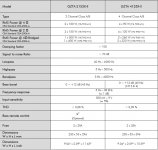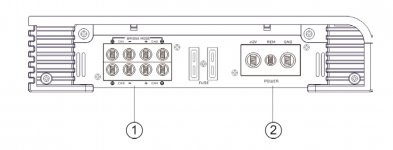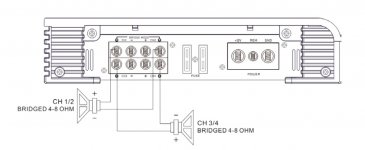Why is the subwoofer overheating at 26v RMS if its somehow not getting 250W RMS? but at 21v RMS its fine?
And this is what i mean by wiring it bridged

my amp has the four outputs on top of each other but its wired the same way as in this picture (where it says mono mine says bridged)
that is not bridging
repeat with me:
THAT-IS-NOT-BRIDGING
Bridging means connecting from + to + or RED to RED
You are connecting from RED to BLACK which is common ground, so it´s irrelevant whether you use the Left Black or the Right Black.
As of:
Why is the subwoofer overheating at 26v RMS if its somehow not getting 250W RMS? but at 21v RMS its fine?
1) Forget the 250W nonsense. That´s NOT what you are measuring.
2) 26V RMS into 4 ohms means 169W RMS
3) 21V RMS into 4 ohms means 110W RMS
4) so by your own admission: your Subwoofer stands 110W RMS ; does NOT stand 169W RMS.
PERIOD.
Stop claiming "I don´t understand it" to keep this thread alive forever.
that is not bridging
I am at loss. So how do you call it? First of all I assume he is using car amplifier and this whole thread is not about home audio. Most of the car amplifier manuals call it bridge mode (see attachments).
Attachments
@JMFahey
maybe it is correct type of bridging, internal construction of car amplifier enables that type of connection. In early '90s I have seen lot of car amplifiers which enables connection of the subwoofer with passive filter to the one pair of stereo speakers (for example if you use it for rear and front combination).
He have to check that - connection point is not on the GND (in that case + connection is grounded of the one stereo channel ), user manual will reveal type of connection if he is uncertain, or doesn't know how to check.
maybe it is correct type of bridging, internal construction of car amplifier enables that type of connection. In early '90s I have seen lot of car amplifiers which enables connection of the subwoofer with passive filter to the one pair of stereo speakers (for example if you use it for rear and front combination).
He have to check that - connection point is not on the GND (in that case + connection is grounded of the one stereo channel ), user manual will reveal type of connection if he is uncertain, or doesn't know how to check.
THAT-IS-NOT-BRIDGING
It might be.
Sometimes, amp manufacturers will run alternate channels out of phase. ie,
Ch1+ = signal
Ch1- = ground
Ch2+ = ground
Ch2- = (inverted) signal
A small number of amplifiers do this, but it certainly isn't unheard of.
In that case, bridged output would be between Ch1+ and Ch2-.
Chris
yes its a ported box
My amplifier is bridged with the channels like that. it is a car audio amplifier im using.
and the box is tuned at 34hz with 1.8 cubic feet per subwoofer.
there is plenty of air movement out of the ports at 30 to 45hz
and even more air movement at 20hz and lower. but i dont smell anything at 20hz and lower cause its moving far enough for the coil to cool itself off and not overheat.
but around tuning frequency it puts more of a load on the subwoofer making it get too hot. the box is definitely not too large otherwise it would be moving a lot at all frequencies and not just below and above port tuning.
at 34hz tuning it barely moves a millimeter when its playing 34hz at max volume
but it moves somewhat at 50hz to 65hz and moves like crazy at 20hz and lower.
My amplifier is bridged with the channels like that. it is a car audio amplifier im using.
and the box is tuned at 34hz with 1.8 cubic feet per subwoofer.
there is plenty of air movement out of the ports at 30 to 45hz
and even more air movement at 20hz and lower. but i dont smell anything at 20hz and lower cause its moving far enough for the coil to cool itself off and not overheat.
but around tuning frequency it puts more of a load on the subwoofer making it get too hot. the box is definitely not too large otherwise it would be moving a lot at all frequencies and not just below and above port tuning.
at 34hz tuning it barely moves a millimeter when its playing 34hz at max volume
but it moves somewhat at 50hz to 65hz and moves like crazy at 20hz and lower.
Last edited:
so is my subwoofers overrated by like half or something then if it overheats at only somewhat over half its RMS rating?
since ive seen plenty of other subwoofer brands tested where they can handle their rated RMS power and more with no problems at all for long periods of time
since ive seen plenty of other subwoofer brands tested where they can handle their rated RMS power and more with no problems at all for long periods of time
Subwoofers are not rated with sinewaves, as a chap above explained.
There isn’t a standard that is universally adhered go by all but the AES system is one of the better ones.
They play pink noise with a dynamic range of 6db for two hours to come up with a rating, pure sine waves at speaker box resonance frequency will fry that speaker in a much shorter time as much more average power is being put into it.
There isn’t a standard that is universally adhered go by all but the AES system is one of the better ones.
They play pink noise with a dynamic range of 6db for two hours to come up with a rating, pure sine waves at speaker box resonance frequency will fry that speaker in a much shorter time as much more average power is being put into it.
reading this thread that is exactly what I was thinkingI think you have answered the question yourself, when playing at resonance the sub is unable to cool itself as effectively as below or even above resonance and therefore gets hotter, causing the smell.
If they don't move enough to bring cooler air in the rating does not apply.so is my subwoofers overrated by like half or something then if it overheats at only somewhat over half its RMS rating?
since ive seen plenty of other subwoofer brands tested where they can handle their rated RMS power and more with no problems at all for long periods of time
You seem to be expecting that the coil is a static load like a filament light bulb and treating it that way.
 Put a 100 watt light bulb in an insulated container and I would suspect that without an ability to radiate the heat away eventually it would accumulate enough heat to fail. The voice coil is rated with an expectation that it will dissipate the heat with air movement. I get what you are saying about smelling the lacquer resin as the coil accumulates enough heat to vaporize the terpenes.
Put a 100 watt light bulb in an insulated container and I would suspect that without an ability to radiate the heat away eventually it would accumulate enough heat to fail. The voice coil is rated with an expectation that it will dissipate the heat with air movement. I get what you are saying about smelling the lacquer resin as the coil accumulates enough heat to vaporize the terpenes.Ive fell down a few rabbit holes getting lost in the numbers and theoretical perfection, its a good exercise,
 but not pragmatic to put into practice, Because real situations are never limited to such monophonic parameters.
but not pragmatic to put into practice, Because real situations are never limited to such monophonic parameters. 
I am at loss. So how do you call it? First of all I assume he is using car amplifier and this whole thread is not about home audio. Most of the car amplifier manuals call it bridge mode (see attachments).
Sometimes, amp manufacturers will run alternate channels out of phase. ie,
Ch1+ = signal
Ch1- = ground
Ch2+ = ground
Ch2- = (inverted) signal
A small number of amplifiers do this, but it certainly isn't unheard of.
In that case, bridged output would be between Ch1+ and Ch2-.
Chris
Wow.
So now Car Audio, the cheesiest branch of Audio defines the rules and calls the show?
Wow double wow.
I´ll stick to the Classic definition of Bridged Amplifier until a better one comes.
Don´t bother me with a worse one.
Wow.
So now Car Audio, the cheesiest branch of Audio defines the rules and calls the show?
Read my post again. That isn't what I said.
I said that sometimes amplifiers are wired in a way that's contrary to the norm. You assumed there was only one way of doing things (bridged from Ch1+ to Ch2+), and that assumption is false.
Chris
No it´s not.
Read it again, including your own:
Please read this carefully until it clicks:
When you invert amp phase, now + becomes - and - becomes +
So when you are connecting from Channel 1 "+" to Channel 2 so called "-" you are actually connecting to Channel 2 "+"
Which by the way is what is required by theory.
That cheesy Car Audio manufacturers omit mentioning that and mislabel output terminals is irrelevant.
"You can´t beat Physics".
As a side note, I *hate* writing this.
I consider you a knowledgeable and sincere Forum Member, and hate seeing you being carried away in one of realflow100 threads, which he on purpose fills with ambiguous statements to make legit forum members "bite" and turn threads into endless inconclusive discussions.
In any case, the real question was about woofer power handling, specifically 21V RMS vs. 24V RMS ; anything else was thrown in as chaff to muddy the waters.
In case it was not clear: no offense intended, at all.
Read it again, including your own:
Sometimes, amp manufacturers will run alternate channels out of phase. ie,
Ch1+ = signal
Ch1- = ground
Ch2+ = ground <---- mislabelled as + , actual ground
Ch2- = (inverted) signal <---- mislabelled as ground , actual +
Please read this carefully until it clicks:
When you invert amp phase, now + becomes - and - becomes +
So when you are connecting from Channel 1 "+" to Channel 2 so called "-" you are actually connecting to Channel 2 "+"
Which by the way is what is required by theory.
That cheesy Car Audio manufacturers omit mentioning that and mislabel output terminals is irrelevant.
"You can´t beat Physics".
As a side note, I *hate* writing this.
I consider you a knowledgeable and sincere Forum Member, and hate seeing you being carried away in one of realflow100 threads, which he on purpose fills with ambiguous statements to make legit forum members "bite" and turn threads into endless inconclusive discussions.
In any case, the real question was about woofer power handling, specifically 21V RMS vs. 24V RMS ; anything else was thrown in as chaff to muddy the waters.
In case it was not clear: no offense intended, at all.
I'll just stick to 21v AC RMS then since my subwoofers dont get hot at all there
and just deal with the fact my subwoofers arent going to get their full rated power without overheating
I think that is the safest approach.
You can optimise this with measurement and a DSP
Plot a graph of voltage against the smell strength to give you a curve of the various safe operating voltage vs sine wave frequency.
You can then correlate these voltages against the volume markings on your knob.
This means you can tweak your knob for in time with the various frequencies when you listen to sine wave music.
In case it was not clear: no offense intended, at all.
None taken at all. The subtleties of tone are difficult to convey through text, so I can see that I might've come across as stand-off-ish. Apologies for that.
We're both saying the same thing, it's just you're looking at what the amp's doing, and I'm looking at the output terminals.
I do see what you mean about this poster's threads, but allow me to have one last attempt at addressing them.
Realflow, the thing to remember is this: the rated wattage for a driver is the maximum power it can take just before melting. If it's rated at 250w, 260w of test signal would kill the driver.
They test the power handling with the driver mounted in free air, probably in an air-conditioned room. That means the driver can cool itself down really easily.
If you put the driver in a small box, it doesn't have much air to dump the heat into, so it's easier to get the driver nice and warm.
If the drivers are starting to smell, that means they're getting close to melting. I don't care if it's above or below what the manufacturer says the driver can take, because they measure under silly conditions that don't really apply. Smell = imminent driver death, unless you turn it down. No ifs, no buts.
If you find 21v RMS means they're not making bad smells, then you're probably fine.
One last thing - running close to the limits is like constantly red-lining your car. It'll last for a while, but it'll be a short and unhappy life.
If you're unhappy with the output from the pair of 12"s you have, maybe it's time to upgrade to either higher-end 12"s, or perhaps some larger cones that can move more air.
Chris
- Status
- This old topic is closed. If you want to reopen this topic, contact a moderator using the "Report Post" button.
- Home
- Loudspeakers
- Subwoofers
- subwoofer bridged voltage wattage RMS question


